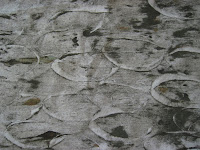Hello All,
I would like to enter the blogging world by offering you all a tutorial. I've learned many techniques from other artists who generously offered ideas, tutorials, and techniques on their blogs and I'd like to share things I discover with you.
I have boxes of old floppy disks from my days as a science teacher. I hate to waste things and I don't want to be a hoarder so I searched on the Internet for ways to use old floppies. I learned how to take them apart and make tiny Starship Enterprises out of them and I saw that you can paint on them to create small artworks. But one evening I had a floppy sitting on a table and I put my coffee mug on top and realized the floppy is a perfect size for a coaster. If used as is, it's not too attractive and condensation from a glass would just run down the plastic onto the table. And if the coaster is made solely from fabric, then the condensation can soak through to the table. The combination of the fabric with the plastic protects the furniture below it. So here is what I made:
What you need for one coaster:
A floppy disc (remove the metal part, pry it open and remove the metal and film inside, close the plastic floppy)
2 pieces of craft felt 4 1/2 inches square
1 piece of background fabric 4 inches square (I used burlap)
Pieces of coordinating fabric (I found that 6-7 different fabrics gave a nice appearance)
Fusible (optional) (I didn't use any)
Steps:
1. Place your background fabric on top of one piece of felt.
2. Place or fuse your scrap fabrics on top of the background fabric.

3. Sew around the edge of the border fabric to attach it to the felt. (I used a decorative stitch so that the burlap wouldn't fray over time.)
4. Sew the fabric scraps onto the background and felt.
5. Place over the second square of felt and line up edges. Straight stitch 3 sides.
6. Tuck in the plastic floppy.
7. Sew up remaining side of felt being careful not to hit the floppy and break the needle. (You could use a zipper foot, but I had plenty of room with a regular foot.)
Here are some I made for Christmas:
Save the metal pieces and find a good use for those. Let me know if you can think of anything good to do with them.
Let me know if you have any questions. Next post may be gelatin monoprinting (if I can get the kitten to take a nap).














